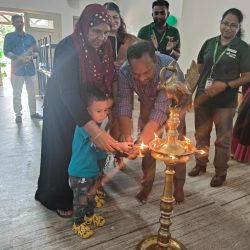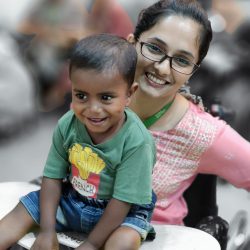A Tryst with Thursday

In this blog series, Smriti Rana, Consulting Psychologist and Program Director for Children’s Palliative Care Project, writes about her experiences at Pallium India’s weekly Children’s Palliative Care Clinic:
What can I tell you about the Thursday Clinic that would adequately sum up the essence of what we witness and experience? Most people’s first reaction to the idea of a clinic for children with life-limiting and life-threatening illness is to recoil – either with the imagined pain, horror, denial and sadness that accompany such an idea, or with the belief that this is the realm of only certain “types” of people, who are “brave”, “courageous” and whatever other associated synonyms you can conjure.
The simple truth, though, is that the people who work at this clinic are not flapping around with halos or wings attached to them. These are everyday folk and by that token, feel everything from intense joy at small victories that are witnessed, to the darkest of despair at the helplessness in some situations.
What makes this space extraordinary, as you can guess, are the children.
The Children’s Palliative Care Clinic was set up in 2012 by Pallium India in collaboration with SAT Government Hospital at the latter’s premises in Trivandrum, Kerala, for 4 hours every Thursday. The vision was to reach out and provide free palliative care to children with a vast range of conditions – neurological disorders and impairments, metabolic diseases, auto-immune diseases, chronic kidney disease, liver disease, malignancies and congenital diseases.
Every week, children of all shapes, sizes and ages stream in, mainly from underprivileged families, most often with their mothers (many of whom are single, after having been abandoned by the husbands once a child with a birth defect is born), sometimes accompanied by both parents or a grandparent, and very often a sibling. The clinic oscillates between chaos and calm, depending on the children that week.
Some are shy and diffident, feeling most secure within a fold of mum’s sari; some are curious and chatty, and some, by virtue of their illness are locked within their own worlds, giving us very few clues as to what this world looks and feels like to them.
At this point, I must confess that I have always considered myself to be terrible with children. So when I walked into that clinic three years ago, it was with more than just a little trepidation. But then an odd thing happened. It turned out that the kids were really good with me.
They forgave my awkwardness, happy to have someone there who was perhaps a little more nervous than they were. They didn’t mind that I didn’t speak their language; they understood me anyway. We forged our friendships relying solely on the universal language of touch, eye-contact and a generosity of smiles. Most of our conversations happened by way of a shared notebook I carried with me every week; some glitter pens (never under-estimate the power of a glitter pen); near-legendary games of knots and crosses or completing squares; drawings of cats, ducks and elephants – quite literally the only three animals I can draw, (if they wanted other animals drawn, I would simply extol the amazing qualities of the three said animals, rendering other animals unworthy of our hallowed notebook).
Coming up on almost 4 years now, being a little more self-assured around them has been a hard-won skill. Just as you settle into a sense of gratification that your work is making a difference, you are blindsided by a complication of the illness, or an externally induced tragedy, usually related to economic conditions. We flounder in the shallows, hoping to muster enough resources to get the ship sailing again while trying very hard to be worthy companions to the children and their families on their journeys.

The other day I accompanied a little boy into a physiotherapy consult. He has been in our care since we started, and despite my best efforts at resistance, has won me over with his almost constant, radiant smile – as demonstrated in the accompanying photograph. He has chronic kidney disease with a host of secondaries that have shaken the bravest of us, even our experienced and unfaltering paediatrician. He has progressively lost mobility and currently has a broken hip and multiple fractures on his shoulder and arm. One of his conditions has resulted in several deposits of calculi in his ureter – in layspeak – he has plenty of kidneystone-like crystals around the clock. I have seen grown men weep thanks to a kidney stone or two, but not this ten year old. Back in the clinic, he patiently waited his turn. It has always been easier for me to watch someone cry than to watch them being brave in the face of insurmountable odds. That day in the clinic, I watched this little boy exhibit amazing grace. The only time he faltered was when a shadow briefly crossed his face as he braced for the excruciating pain he was certain was coming. It was my undoing.
We have now launched what appears to be a very successful toy donation drive via social media. The toys are coming in from all over the world and are lighting up the hearts of not just our little patients, but also their often-invisible siblings, many of whom have never owned a real toy in their lives; and providing a stunningly positive connection between these families and those who are out there in the world on a relatively better wicket. It is uplifting, heartening and proof of the incredible kindness that exists in the face of unspeakable pain, making the Thursday clinic a happier space, one in which the children are bubble-wrapped for a few hours every week.
Over the next few weeks and possibly months, we will bring you more stories from the Thursday Clinic. In the next few months we also hope to evolve from just a weekly clinic to a 24/7 facility.
Walk with us, into this most special of places.





Now this is awesomely amazing to know you are sharing your experiences and spreading the message!
Thank you and keep writing….God Bless
Hi smriti – beautifully written . Kudos to your efforts here. I used to volunteer with spas tics society of India while I was in Bangalore and work its disabled children
Do you have any branches in Bangalore ? I will be in blore in July and would like to volunteer if possible
Hello, awesome writing. Thank you Sharing your Experiences.
Great work smriti x
You are truly blessed to be working in a place like this. No one will ever comprehend the toll it takes on you. Look forward to your updates.
I’m interested in working with you guys..hv a family..small children..defence job..meaning moving perpetually..live in ludhiana at present..palliative care is close to my heart…howcan i help?
Dear smriti
I cried when I read this… Your words brought the children to life as well as their stories. Thank you for sharing this and inspiring me. This really touched a chord with me and brought back to life certain things that I had forgotten… For a second I stopped rushing around in this mad hectic world of ours, stood still for a moment and remembered the joy of working with children and the thrill of calming a little heart or lighting up one of their big smiles. I will be in touch with you but I wanted to tell you how much your words affected me and made me want to be better and do better… Much love
We wish you strength, courage, a heart filled with Love & care to share the way you are with these Kids. May you always be blessed with a smile on your face & joy in your heart. So so proud of you & your efforts Smriti. God bless you!